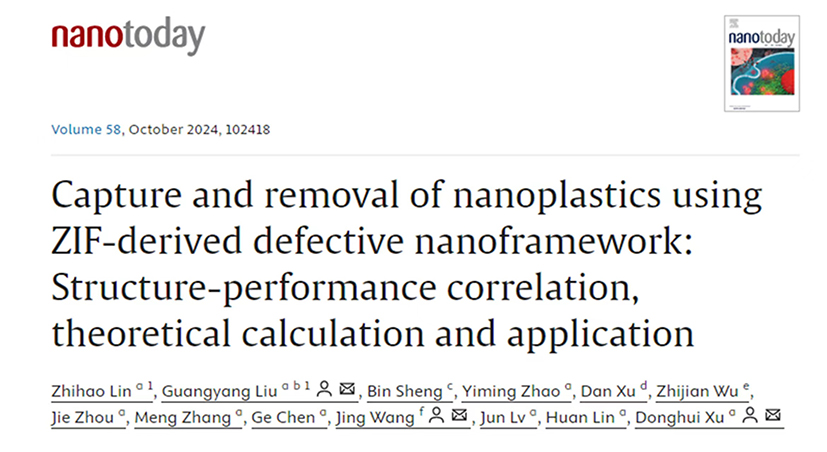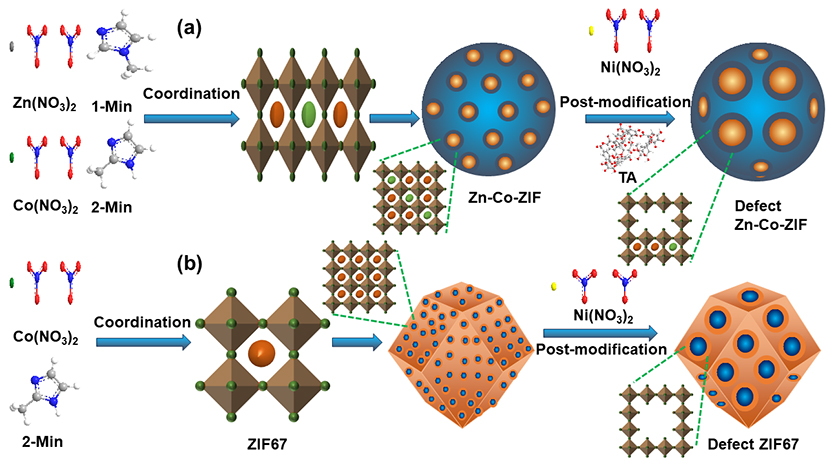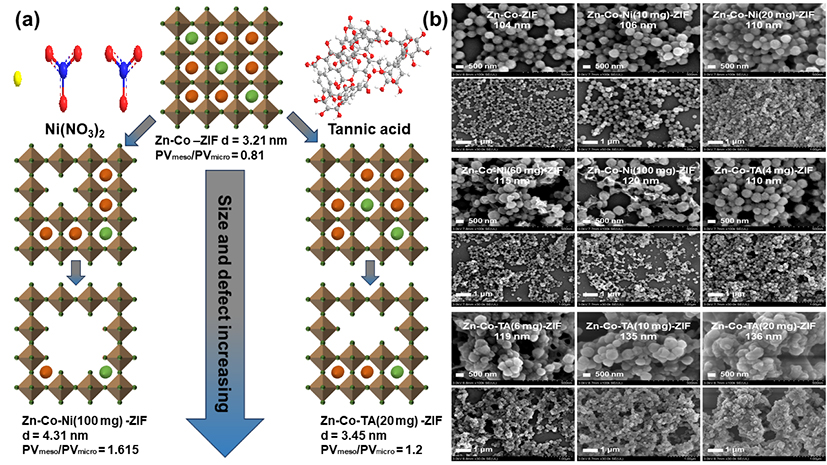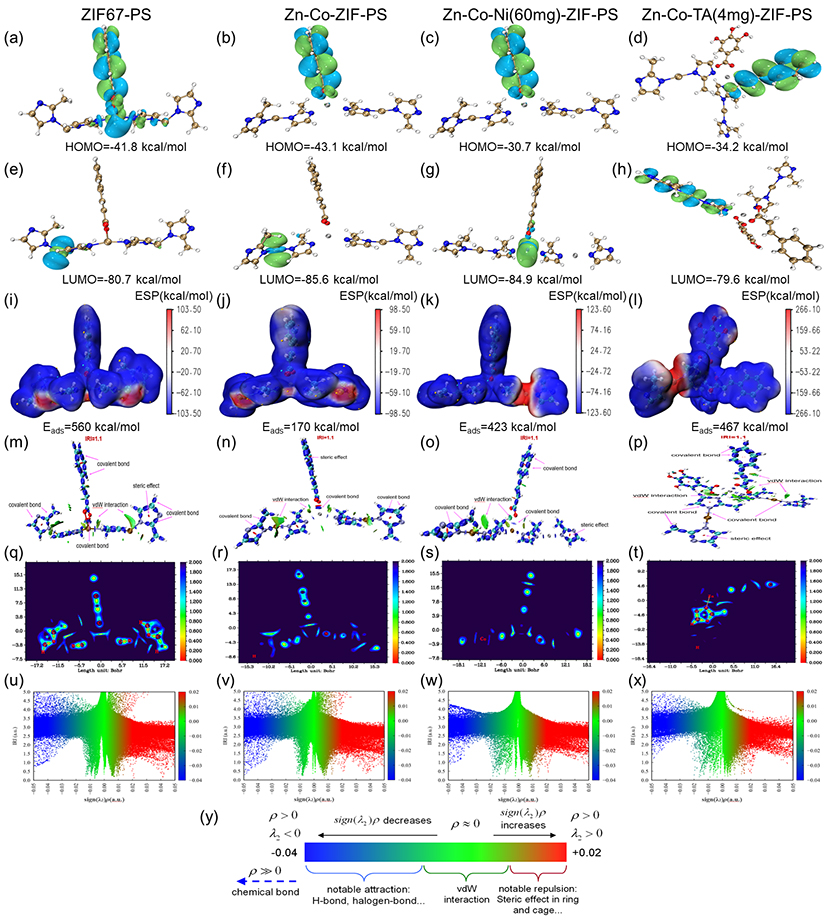Recently, the Quality and Safety Research Group of the Institute of Vegetables and Flowers, Chinese Academy of Agricultural Sciences (CAAS) has made important progress in the structure-activity grey correlation analysis of defective ZIF nanoframeworks, quantum theoretical calculations and their application of the capture and removal of fruit and vegetable nanoplastics. The recognition and interaction mechanism between ZIF nanoframeworks and nanoplastics was analyzed by density functional theory calculations, and was successfully applied to the capture and removal of nanoplastics in fruit and vegetable juice. The relevant research results are entitled " Capture and removal of nanoplastics using ZIF-derived defective nanoframework: structure-performance correlation, theoretical caculation and application "in Nano Today (IF=13.2, Q1).

With the continuous use of plastic products, microplastics (MPs) and nanoplastics (NPs) are widely detected in the atmosphere, water and soil. Mulch film is a commonly used agricultural input in the production of horticultural products such as fruits and vegetables. The micro-nano plastics produced by the degradation of plastic film will migrate and transport during the growth and development of fruits and vegetables, and gradually accumulate in different parts of the plant. Due to their small size, high stability, refractory degradation, and enrichment and transformation in ecosystems and food chains, micro-nano plastics pose a great threat to the ecological environment, the quality safety of agricultural products, and human health. The detection, prevention and control of micro-nano plastics have become a hot area of scientific and public concern.
MOFs based porous materials have significant advantages in the adsorption and trapping of microplastics, such as large specific surface area, high porosity, excellent chemical stability, significant functional group tunability, and simple preparation process. However, MOFs also have some problems such as deep burial of active sites, slow mass transfer, and low efficiency, especially in the adsorption and removal of ultra-small microplastics. Defect engineering is a commonly used synthesis strategy in the design and fabrication of functional nanomaterials. Through defect engineering, the microstructure, chemical composition, and unsaturated coordination of MOFs can be precisely controlled, to fully expose the active sites in the framework, reduce the diffusion resistance of pollutants, improve the selection and identification characteristics, and increase the adsorption capacity and mass transfer rate. In addition, the microscopic changes of defective MOFs can significantly affect the physical and chemical properties of materials, such as pore size, porosity, specific surface area, crystal structure, and recognition adsorption properties. It is of great theoretical and practical significance to analyze the structure-activity relationship between the structural evolution of defective MOFs and the change of recognition performance, reveal the basic reaction theory of defective MOFs to identify and control micro-nano plastic pollutants, construct a new micro-nano plastic control removal technology and improve the quality and safety level of horticultural products such as fruits and vegetables.
Based on the above design, a series of defective ZIF nanoframework materials with different morphologies and structural characteristics (Zn-Co-Ni-ZIF, Zn-Co-TA-ZIF and ZIF67-Ni-ZIF) were prepared by defect engineering (chemical etching after synthesis). In this study, the correlation between the structural characteristics of defective ZIF nanoframework and the adsorption performance of PS-NPs was studied by using nano-characterization techniques and grey prediction models. Combined with DFT quantum theory calculations, the recognition and interaction mechanism between ZIF nanoframeworks and nanoplastics was analyzed. The results show that the correlation between the adsorption performance of PS-NPs and the structural parameters is Co2p intensity> M-N intensity> number of linker defects> number of crystal defects> zeta potential. The grey model (GM) (1,1) was used to construct a correlation model between the structure of the ZIF nanoframework and the recognition adsorption performance (C < 0.342; RSD < 18.108%). The selective adsorption capacity of defective ZIF for polystyrene nanoplastics (PS-NPs) can be greatly improved by introducing additional defects and enhancing adsorbent-adsorbate interactions, including electrostatic and coordination interactions. Under the optimal experimental conditions, the defective ZIF nanoframeworks were successfully applied to the efficient adsorption of polystyrene nanoplastics in fruit and vegetable juice samples such as watermelon, strawberry and carrot, with a removal rate of 83.55%-87.80%. The metal ion migration residue test further demonstrated the environmental safety of the defective ZIF nanoframework in the nanoplastic capture process. This study provides a new idea for the design and preparation of defective MOFs, the research and development of functional modification and pollutant control removal technology, offering a new research mode for in-depth understanding of the identification and interaction mechanism of porous defective adsorbent materials and the analysis of structure-activity correlation relationship.
Institute of Vegetables and Flowers, Chinese Academy of Agricultural Sciences (CAAS) is the first unit to complete the paper. Ph.D. students Zhihao Lin and Prof. Guangyang Liu are the co-first authors of the paper, and Prof. Guangyang Liu, Prof. Jing Wang (Institute of Agricultural Quality Standards and Testing Technology, Chinese Academy of Agricultural Sciences) and Prof. Donghui Xu are the co-corresponding authors. The research was carried out in the State Key Laboratory of Vegetable Biological Breeding and Key Laboratory of Vegetables Quality and Safety Control, supported by National Key Research and Development Program of China, the National Bulk Vegetable Industry Technology System, Beijing Natural Science Foundation, and Agricultural science and technology Innovation Project of the Chinese Academy of Agricultural Sciences.
Web site of the paper: https://www.sciencedirect.com/science/article/pii/S1748013224002743?dgcid=author

Fig.1 Flow chart of the preparation of ZIF-derived nanoframeworks.

Fig.2 Schematic diagram of the modified pore size structure of Zn-Co-Ni-ZIF and Zn-Co-TA-ZIF nanoframeworks with different molecular sizes.

Fig. 3 Grey correlation analysis and grey prediction model GM (1,1) of Zn-Co-Ni-ZIF, Zn-Co-TA-ZIF, and ZIF67-Ni-ZIF.

Fig. 4 Highest occupied molecular orbitals (HOMO) of (a) ZIF67-PS, (b) Zn-Co-ZIF-PS, (c) Zn-Co-Ni(60 mg)-ZIF-PS and (d) Zn-Co-TA(4 mg)-ZIF-PS. Lowest unoccupied molecular orbitals (LUMO) of (e) ZIF67-PS, (f) Zn-Co-ZIF-PS, (g) Zn-Co-Ni(60 mg)-ZIF-PS and (h) Zn-Co-TA(4 mg)-ZIF-PS. Electrostatic potential of (i) ZIF67-PS, (j) Zn-Co-ZIF-PS, (k) Zn-Co-Ni(60 mg)-ZIF-PS and (l) Zn-Co-TA(4 mg)-ZIF-PS. Interaction region indicator (IRI)=1.1 isosurface map of (m) ZIF67-PS, (n) Zn-Co-ZIF-PS, (o) Zn-Co-Ni(60 mg)-ZIF-PS and (p) Zn-Co-TA(4 mg)-ZIF-PS. IRI map on the dimer plane of (q) ZIF67-PS, (r) Zn-Co-ZIF-PS, (s) Zn-Co-Ni(60 mg)-ZIF-PS and (t) Zn-Co-TA(4 mg)-ZIF-PS. Scatter map between IRI and sign(λ2) ρ of (u) ZIF67-PS, (v) Zn-Co-ZIF-PS, (w) Zn-Co-Ni(60 mg)-ZIF-PS and (x) Zn-Co-TA(4 mg)-ZIF-PS. (y) Standard coloring method and chemical explanation of sign(λ2)ρ on IRI isosurfaces.